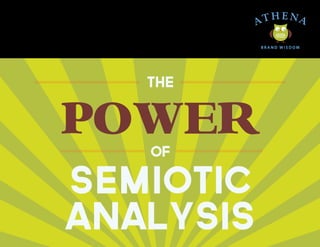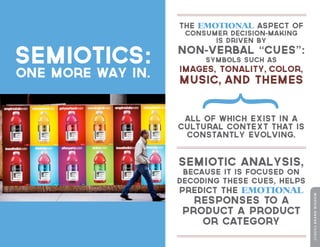An Introduction to Marketing Semiotics.pdf
- 2. Times have changed in Market Research We now know that decision-making is EMOTIONAL RATIONAL 2 nd 1 st
- 3. Times have changed in Market Research in fact of information processing goes on at the subconscious (EMOTIONAL) level
- 4. Although there are many methodologies that describe the RATIONAL part of decision-making, getting the EMOTIONAL side has always been more challenging. Times have changed in Market Research Consumers can’t always access non-verbal processing, so can’t report back on its impact.
- 5. A number of methodologies are exploring ways to tap into the EMOTIONAL side of decision- making: • Neuro-Marketing • Hypnosis • Ethnographic observation • Micro-expression analysis • Metaphor Elicitation What we are now learning is that the best outcomes are often derived by using multiple methodologies to build a composite understanding. {
- 6. Semiotic analysis, because it is focused on decoding these cues, helps predict the EMOTIONAL RESPONSES TO A PRODUCT A PRODUCT OR CATEGORY The EMOTIONAL aspect of consumer decision-making is driven by non-verbal “cues”: symbols such as images, tonality, color, music, and themes all of which exist in a cultural context that is constantly evolving. Semiotics: One More Way In. {
- 7. semiotics defined • The study of cultural symbolism: of how meaning is conveyed through all aspects of communication: words, images, sounds, scents, textures, behavior, etc. • A form of cultural analysis rooted in linguistics, anthropology and literary criticism (related to ethnography). • A formal process employing specific analytical tools. {
- 8. Looks deeply at the signs related to a brand or category, and their meanings in a culture. Provides additional insight because it’s focused on those symbolic elements of communication that we are less conscious of. Is a great way to make sense of the relationship between consumers, brands, and the cultures they live in. marketing semiotics defined A qualitative marketing research approach focused on the analysis of symbolic communication. {
- 9. Semiotic Analysis uses all of culture as its database, because every aspect of a culture conveys messages and meaning. Depending on the project, sources of data can range from a magazine ad to a consumer’s home to a government website. Books Media (news & pop culture) Advertising Packaging Quant or qual research Websites Stores Street fashion Expert interviews Brand histories Museums Marketing Semiotics Data Sources Sources:
- 10. what can semiotics be used for? Tracking and analyzing social and marketing trends Understanding of culture in a new market Mapping brand positionings within a category Evaluating the communications effectiveness of advertising, packaging, websites, social media Evaluating the and Improving the at-shelf experience Optimizing brand communications across cultures Articulating the cultural role of a product/brand Determining optimal cues for brands across all touch-points Identifying new positioning opportunities Semiotic Analysis can be used at any stage of the strategic development process, on its own or in conjunction with other methods.
- 11. • Pharmaceutical companies in heavily regulated markets (i.e. outside U.S.A). • Mature categories where products have very few functional differences. • Complex categories where product differences are difficult to convey concisely/in laymen’s terms (i.e. technology, financial services). Semiotics is also invaluable for ensuring optimal communication in different cultural contexts. when semiotics really shines Semiotics is a great choice for categories where brand differences cannot be spelled out through language:
- 12. Fundamentally it’s about improving communications efficiency and efficacy. Benefits of Semiotic Analysis For Clients Improves ROI Manages risk By revealing all potential messages brand communication may be conveying (whether intended or not) Strengthens communication Can identify most resonant cues and most relevant brand positioning the more powerful and positive associations a brand has, the greater its brand involvement
- 13. AXE BORROWS THE PISTOL-GRIP SHAPE FOR ITS PACKAGING TO SYMBOLICALLY SUPPORT ITS DESIRED "MASCULINE POWER" BRAND ASSOCIATION. feel more “manly” when using Axe. Semiotic Analysis Example: packaging {
- 14. Three Packages: Essentially the same product, but design cues convey dramatically different notions, thereby creating radically different product expectations. competitive messaging { Bare bones packaging conveys sense of basic product, unmediated by “marketing” and therefore cheaper. Consumers can expect a straightforward chip experience, without any bells and whistles. Rich use of imagery and colour suggests a significantly more engaging product experience that is worth paying for. Use of the colour red, images of flames and electric shock, “3rd Degree Burn” language, all work to convey intensity and excitement. Use of illustration and cursive font suggests a “handmade” product. Images of vegetable ingredients, verbal cues like “natural” and “sea salted” imply authenticity and health. Implication that this is almost home-made, not mass- marketed. Semiotic Analysis Example:
- 15. Dominant Depiction of “Mom” is still rooted in the 1950s: Suburban, middle class, domestic, and at the service of her children. This depiction does not acknowledge the multiple approaches to modern motherhood. pop culture analysis { Depictions of “Motherhood” in Popular Culture Semiotic Analysis Example:
- 16. semiotic analysis example: brand mapping authority rebel intuitive analytical Reactive Control Conservatism Efficiency Abstract Innovation Liberation Heritage Sensory Common Sense Creativity Avant--Garde
- 17. Australian Aboriginals: Land, earth Celtic: Death, afterlife China: Good luck, celebration, summoning Cherokees: Success, triumph Hebrew: Sacrifice, sin India: Purity South Africa: Mourning Russia: Bolsheviks and Communism Risk Management RED Semiotic Analysis Example:
- 18. This price-point was chosen because Steve Wozniak was a math geek and considered repeating numbers to be “cool”. But not everyone interpreted it that way. { RISK MANAGEMENT Semiotic Analysis Example:
- 19. pitching semiotics to CLIENTS 1. Semiotics is a rigorous methodology that is becoming more mainstream. 2. More world leading brands are using it every day. 3. Semiotics can help manage risk by identifying messaging watch-outs. 4. Semiotics can help a brand leverage emergent cultural trends. 5. Semiotics can enhance the value from other research they are doing.
- 20. why ATHENA? ? Experience – formal training and experience in a variety of categories. We’ll partner with you on semiotics initiatives and share the revenue related to the project. We can tailor the approach to suit the objectives of a particular client.
- 21. after 15 years in Advertising Account Planning in the U.K., U.S. and Canada, she founded a research and planning consultancy about Sarah Jane Johnson SARAH JOHNSON is a commercial semiotician who has conducted analyses ranging from Obesity in American Media and Popular Culture to a Historical Analysis of Ritz Cracker advertising. { Sarah studied Anthropology, Philosophy and English at McGill University and English Literature at Cambridge.






















